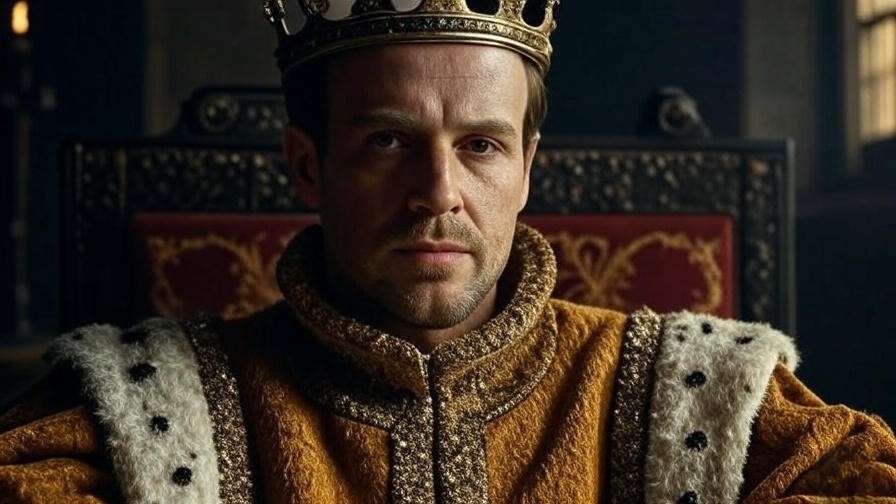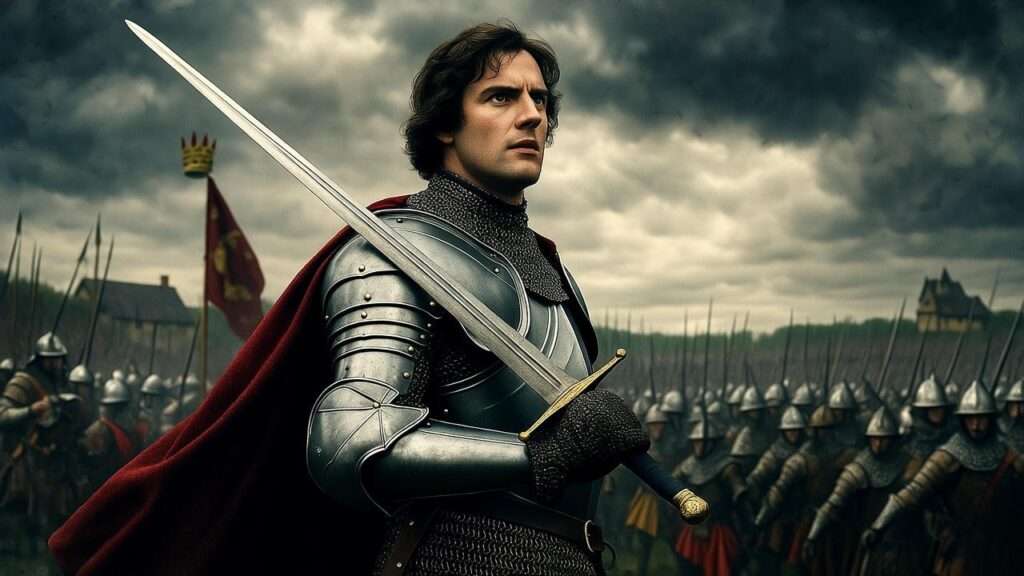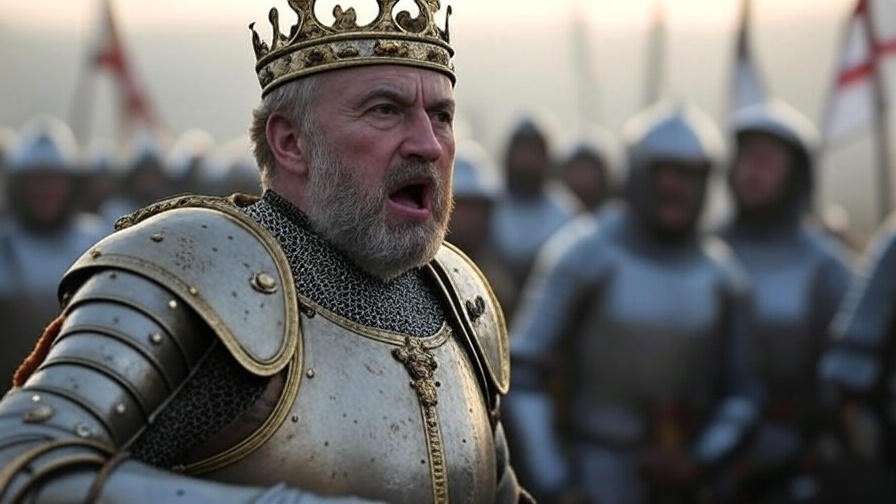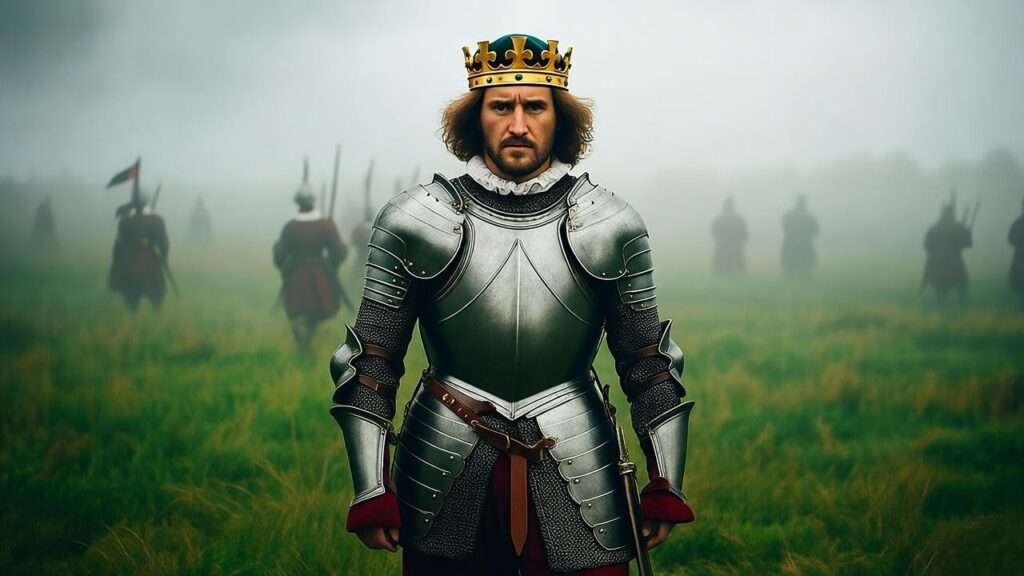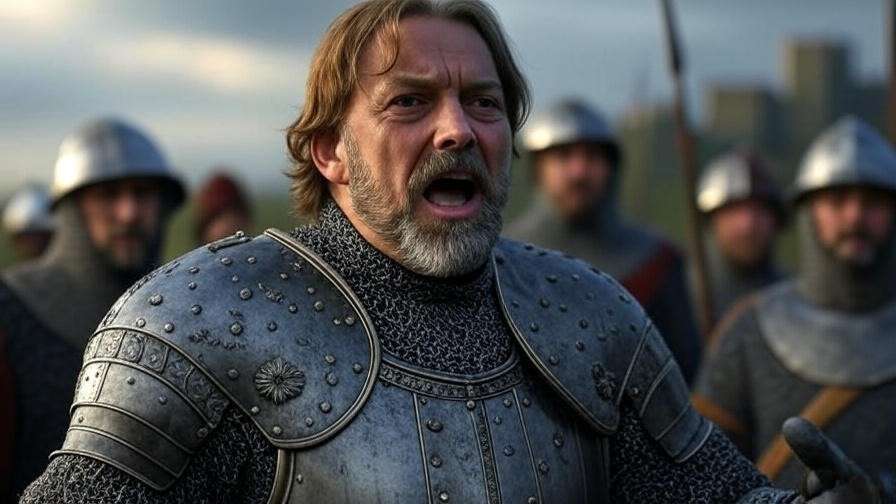Picture a muddy battlefield in 1415, where a young King Henry V stands before his weary, outnumbered English troops. With rain-soaked armor and unwavering resolve, he delivers the immortal “Band of Brothers” speech, igniting courage in the face of impossible odds. This is the heart of Henry V, Shakespeare’s gripping history play that weaves leadership, war, and moral complexity into a timeless narrative. For students, educators, and Shakespeare enthusiasts seeking a clear Henry V summary, this article offers a comprehensive guide to the play’s plot, themes, characters, and modern relevance. As a Shakespeare scholar with years of teaching and analyzing the Bard’s works, I’ve crafted this in-depth exploration to illuminate Henry V’s enduring power, ensuring you grasp its essence and significance.
What Is Henry V? An Overview of Shakespeare’s Historical Epic
The Play’s Historical Context
Henry V transports us to the Hundred Years’ War, specifically the 1415 campaign where England’s King Henry V pursued his claim to the French throne. Rooted in historical events, the play draws from chronicles like Raphael Holinshed’s, blending fact with dramatic flair. The pivotal Battle of Agincourt, where Henry’s small army triumphed against a larger French force, anchors the narrative. Shakespeare, writing in 1599, used this historical backdrop to explore leadership and national pride, resonating with Elizabethan audiences eager for tales of English valor.
Genre and Structure
As the final chapter of Shakespeare’s Henriad tetralogy (Richard II, Henry IV Part 1 & 2, Henry V), this history play combines political drama, comedy, and epic storytelling. Its five-act structure, guided by a unique Chorus, unfolds like a cinematic journey, bridging scenes with vivid commentary. The Chorus apologizes for the stage’s limitations while urging audiences to imagine grand battles, enhancing the play’s theatricality. This structure makes Henry V both a historical recounting and a meditation on storytelling itself.
Why Henry V Matters Today
Why does a 400-year-old play still captivate us? Henry V tackles universal themes—leadership, sacrifice, and the moral cost of war—that echo in modern contexts, from political leadership to global conflicts. As noted Shakespeare scholar Emma Smith observes, “Henry V challenges us to question the cost of glory, making it a mirror for today’s debates on power and ethics.” Whether you’re a student decoding the text or a leader seeking inspiration, the play offers timeless lessons.
Plot Summary of Henry V
Act 1 – The Call to War
The play opens with the young King Henry V contemplating war with France, spurred by a provocative gift of tennis balls from the French Dauphin, mocking his youth. Advised by the Archbishop of Canterbury, who justifies Henry’s claim to the French throne, Henry resolves to invade. This act establishes Henry’s transformation from the reckless Prince Hal of Henry IV to a decisive monarch. Political maneuvering and diplomatic tensions set the stage for the epic conflict ahead.
Act 2 – Challenges and Betrayals
As Henry prepares for war, he uncovers a plot by trusted nobles—Scroop, Cambridge, and Grey—to assassinate him. His swift, just response showcases his growing authority. Meanwhile, a comic subplot introduces Falstaff’s former companions—Pistol, Nym, and Bardolph—whose bumbling antics contrast with the play’s gravity. The act balances high-stakes political drama with earthy humor, highlighting the diverse faces of Henry’s England.
Act 3 – The Siege of Harfleur and the St. Crispin’s Day Speech
Henry’s campaign intensifies at the siege of Harfleur, where his rousing “Once more unto the breach” speech galvanizes his troops. Later, facing a vastly larger French army at Agincourt, Henry delivers the iconic St. Crispin’s Day speech: “We few, we happy few, we band of brothers.” This moment, blending camaraderie and resolve, cements Henry’s legacy as a charismatic leader. The speech’s emotional power inspires his men to fight against all odds.
Act 4 – The Battle of Agincourt
The Battle of Agincourt is the play’s climax, where Henry’s strategic brilliance and sheer determination lead to an improbable English victory. Shakespeare portrays the chaos and heroism of battle, but also its moral shadows—Henry’s order to kill French prisoners raises ethical questions. The victory, celebrated as a divine triumph, underscores Henry’s leadership while prompting reflection on war’s costs.
Act 5 – Peace and Marriage
The play concludes with the Treaty of Troyes, securing peace and Henry’s marriage to Princess Katherine of France. Their charming, if politically motivated, courtship scene blends humor with diplomacy. Yet, the Chorus foreshadows future strife, noting that Henry’s son, Henry VI, will lose France. This bittersweet ending tempers the play’s triumph with historical perspective, inviting audiences to ponder the fleeting nature of glory.
Key Themes in Henry V
Leadership and Kingship
Henry’s journey from wayward prince to revered king is central to Henry V. His ability to inspire—through speeches like “Once more unto the breach”—and connect with common soldiers showcases a leadership style that feels strikingly modern. He blends charisma, empathy, and decisiveness, qualities echoed in today’s leadership theories. For instance, his disguise among troops before Agincourt mirrors modern leaders engaging directly with their teams.
War and Its Costs
Shakespeare glorifies war’s heroism but doesn’t shy away from its brutality. The deaths of Bardolph and the French prisoners highlight war’s moral toll. Tip: As you read Henry V, consider how Shakespeare balances patriotic fervor with subtle critiques, inviting reflection on war’s true cost. This duality makes the play a rich text for debating the ethics of conflict.
National Identity and Unity
Henry V celebrates English pride, yet its inclusion of Welsh, Scottish, and Irish soldiers—Fluellen, Macmorris, and Jamy—suggests a broader vision of unity. The play’s patriotic tone resonated with Elizabethans, but its diverse cast hints at a nuanced view of national identity, relevant to today’s multicultural societies.
Morality and Ambiguity
Henry’s decisions, like justifying war or executing traitors, raise moral questions. Is he a hero or a pragmatist willing to bend ethics for victory? Literary critic Harold Bloom notes, “Shakespeare’s Henry is both inspiring and troubling, a leader whose virtues are inseparable from his flaws.” This ambiguity invites readers to grapple with the complexities of power.
Key Characters and Their Roles
King Henry V
Henry is the play’s heart, evolving from the roguish Prince Hal into a shrewd, inspiring king. His speeches and actions—like mingling in disguise with his soldiers—reveal a leader who balances authority with empathy. Key moments, such as his St. Crispin’s Day speech, define his legacy as a unifying figure.
Supporting Characters
|
Character |
Role |
Motivation |
|---|---|---|
|
Chorus |
Narrator who frames the story, urging audiences to imagine epic scenes. |
Enhances theatricality and historical context. |
|
Pistol, Nym, Bardolph |
Falstaff’s former companions, providing comic relief. |
Highlight the human cost of war through their fates. |
|
Dauphin |
Arrogant French prince whose mockery incites Henry. |
Represents French hubris. |
|
Katherine |
French princess whose marriage to Henry seals peace. |
Adds a humanizing, diplomatic subplot. |
The Role of the Chorus
The Chorus, a unique feature, acts as a storyteller, apologizing for the stage’s limits while painting vivid images of war and royalty. For example, the Chorus’s opening lines—“O for a Muse of fire”—set an epic tone, inviting audiences to engage their imaginations. This narrative device makes Henry V uniquely immersive.
Historical Accuracy vs. Dramatic License
What’s Historically Accurate?
Henry V draws heavily from historical events, notably the 1415 Battle of Agincourt, where English archers decimated a larger French force. The Treaty of Troyes and Henry’s marriage to Katherine are also factual. Shakespeare relied on Holinshed’s Chronicles, grounding the play in documented history.
Shakespeare’s Creative Additions
Elements like the Dauphin’s tennis balls and Falstaff’s companions are fictional, designed to heighten drama and humor. The tennis balls, for instance, amplify the Dauphin’s arrogance, making Henry’s resolve more compelling. These additions enrich the narrative without sacrificing historical essence.
Why It Works
Shakespeare’s blend of fact and fiction creates a gripping story that resonates emotionally and intellectually. Tip: Compare Henry V to historical accounts, like those in the Folger Shakespeare Library, to appreciate Shakespeare’s artistry in balancing truth and drama.
Henry V in Performance and Popular Culture
Notable Stage and Film Adaptations
Henry V has inspired iconic performances across centuries. Laurence Olivier’s 1944 film, created as wartime propaganda, emphasizes patriotic fervor, with sweeping visuals of Agincourt. In contrast, Kenneth Branagh’s 1989 adaptation takes a grittier approach, highlighting the human cost of war. Modern stage productions, such as those by the Royal Shakespeare Company, often explore the play’s moral ambiguities, presenting Henry as both hero and flawed pragmatist. Each adaptation reinterprets the play’s themes, making it accessible to new generations.
Influence on Modern Media
The play’s themes and speeches resonate beyond the stage. The St. Crispin’s Day speech, with its “band of brothers” imagery, is frequently quoted in leadership training and political rhetoric. For example, business leaders and coaches cite Henry’s motivational tactics to inspire teams. In pop culture, Henry V’s portrayal of unity and sacrifice echoes in war films and leadership narratives, cementing its influence on modern storytelling.
Tips for Watching or Reading Henry V
To fully appreciate Henry V, focus on the Chorus’s vivid descriptions, which set the epic tone. Pair the text with a strong adaptation, like Branagh’s film, to visualize the battles and speeches. Tip: When reading, annotate key speeches like “Once more unto the breach” to unpack their rhetorical power. Attending a live performance can also bring the play’s energy to life, especially in scenes of camaraderie or conflict.
Why Henry V Resonates with Modern Audiences
Leadership Lessons from Henry
Henry’s leadership style offers timeless lessons. His ability to inspire through speeches, empathize with soldiers, and make tough decisions mirrors modern leadership principles. Here are 5 Leadership Takeaways from Henry V:
- Inspire with Vision: Henry’s St. Crispin’s Day speech unites his troops by painting a shared purpose.
- Lead by Example: He risks his life alongside his men, earning their loyalty.
- Adapt to Challenges: Henry adjusts strategies, like using archers at Agincourt, to overcome odds.
- Show Empathy: His disguised conversations with soldiers reveal genuine care.
- Balance Justice and Mercy: Henry’s handling of traitors shows firmness tempered with fairness.
These principles resonate with today’s leaders, from CEOs to community organizers, seeking to motivate and unify teams.
Relevance to Current Events
Henry V speaks to contemporary issues like national unity, ethical leadership, and the costs of conflict. Its portrayal of a diverse army—English, Welsh, Scottish, Irish—parallels modern discussions on multiculturalism and inclusion. The play’s moral questions, such as the ethics of war, align with debates over military interventions or political leadership. For instance, Henry’s justifications for war echo modern leaders navigating global tensions. Leadership coach John Maxwell notes, “Henry V’s ability to rally diverse groups offers a model for today’s polarized world.”
Educational Value
In classrooms, Henry V serves as a rich text for studying history, literature, and ethics. Students analyze its language to understand Shakespeare’s rhetorical genius, while history buffs explore its depiction of the Hundred Years’ War. The play’s moral dilemmas spark discussions on leadership and justice. Tip: Use these discussion questions in book clubs or classrooms:
- How does Henry balance charisma with moral responsibility?
- Does Shakespeare glorify or critique war in Henry V?
- How do the play’s themes apply to modern leadership challenges?
FAQs About Henry V
What is the main plot of Henry V?
Henry V follows King Henry V’s campaign to conquer France, culminating in the 1415 Battle of Agincourt. Through political intrigue, rousing speeches, and moral dilemmas, the play traces his transformation into a legendary leader, ending with a peace treaty and marriage to Princess Katherine.
Is Henry V historically accurate?
While rooted in history, Henry V blends fact with fiction. The Battle of Agincourt and Treaty of Troyes are accurate, but elements like the Dauphin’s tennis balls are Shakespeare’s inventions, drawn from Holinshed’s Chronicles, to heighten drama.
Why is the St. Crispin’s Day speech so famous?
The St. Crispin’s Day speech is renowned for its emotional power and rhetorical brilliance: “We few, we happy few, we band of brothers.” It transforms a desperate moment into one of unity and glory, inspiring audiences and leaders alike.
How does Henry V fit into Shakespeare’s other works?
As the final play in the Henriad tetralogy (Richard II, Henry IV Part 1 & 2, Henry V), it completes Henry’s arc from reckless prince to heroic king. Unlike Shakespeare’s tragedies, it emphasizes triumph, though with nuanced critiques of power.
What are the best ways to enjoy Henry V?
Read the play with a focus on its speeches, watch Branagh’s or Olivier’s film adaptations, or attend a live performance. Engaging with the text alongside visual or theatrical versions enhances its impact and accessibility.
Henry V is more than a historical drama—it’s a profound exploration of leadership, war, and morality that resonates across centuries. From the rousing St. Crispin’s Day speech to the moral complexities of Henry’s decisions, Shakespeare’s masterpiece offers timeless insights for students, leaders, and literature lovers. This Henry V summary has unpacked its plot, themes, characters, and modern relevance, providing a comprehensive guide to understanding its brilliance. Dive deeper into Shakespeare’s world by exploring related articles on our or share your thoughts on Henry V in the comments below. For further reading, visit the Folger Shakespeare Library or Oxford University Press for authoritative resources.

